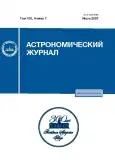LONG MAGNETIC MINIMUM OF HD 166620 – POSSIBLE BEGINNING OF THE ANALOGUE OF THE MAUNDER MINIMUM
- Авторлар: Savanov I.S.1
-
Мекемелер:
- Institute of Astronomy of the Russian Academy of Sciences
- Шығарылым: Том 100, № 7 (2023)
- Беттер: 611-620
- Бөлім: Articles
- URL: https://journals.rcsi.science/0004-6299/article/view/139109
- DOI: https://doi.org/10.31857/S0004629923070095
- EDN: https://elibrary.ru/NEDRAN
- ID: 139109
Дәйексөз келтіру
Толық мәтін
Аннотация
Based on photometric observations published in the literature, the manifestations of the activity of the K2V dwarf HD 166620 were studied. The obtained results are compared with the results of the analysis of the chromospheric activity of the star. HD 166620 is entering in a long magnetic minimum and may be the first reliable candidate for objects that are at a minimum of activity similar to the Maunder minimum (MM) of the Sun. Studies of changes in the magnetic activity of the star were carried out based on the values of the S‑index (1885 measurements in the observation interval for 53.6 years), obtained mainly before its entry into the MM phase, and on photometric measurements of the brightness in the b and y filters covering 17 seasons from 1993 to 2020 obtained with the automatic APT telescope (MM phase and its beginning). It has been established that the Kamogata Wide-field Survey observation data combined into a single array in filters B, V and Ic (about 1400 measurements) convincingly demonstrates the long-term variability of the HD 166620 brightness in the phase of the probable MM state. At the same time, the observations of the Kamogata Wide-field Survey fill the gap in the photometric data of the APT automatic telescope well. The value of the cycle (about 4000 days) is comparable to the duration of observations, with its refinement by according to the data of a larger time interval, it is possible that it will correspond more to the value found from the data on chromospheric activity. The main results of the work should include the cyclic long-term changes in the activity of the star detected by us during the beginning of the MM phase. The question of clarifying the value of the rotation period HD 166620 remains open. There were no significant peaks corresponding to the value P = 45.06 days, previously accepted as the period of rotation of the star, on almost all the power spectra constructed by us. It is noted that further observations are required to establish the full duration of the minimum phase of the star’s activity.
Негізгі сөздер
Авторлар туралы
I. Savanov
Institute of Astronomy of the Russian Academy of Sciences
Хат алмасуға жауапты Автор.
Email: isavanov@inasan.ru
Russia, Moscow
Әдебиет тізімі
- A. Biswas, B. B. Karak, I. Usoskin, and E. Weisshaar, Space Sci. Rev. 219(3), id. 19 (2023).
- R. Egeland, W. Soon, S. Baliunas, J. C. Hall, A. A. Pevtsov, and L. Bertello, Astrophys. J. 835, id. 25 (2017).
- S. P. Shah, J. T. Wright, H. Isaacson, A. W. Howard, and J. L. Curtis, Astrophys. J. 863, id. L26 (2018).
- A. C. Baum, J. T. Wright, J. K. Luhn, and H. Isaacson, Astron. J. 163(4), id. 183 (2022).
- J. K. Luhn, J. T. Wright, G. W. Henry, S. H. Saar, and A. C. Baum, Astrophys. J. 936, id. L23 (2022).
- R. A. Donahue, S. H. Saar, and S. L. Baliunas, Astrophys. J. 466, 384 (1996).
Қосымша файлдар














